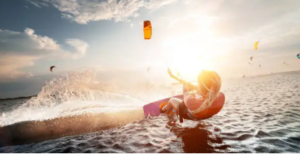Wing foiling is an exciting new board-riding sport that uses a hydrofoil to harness wind power without the need for a breaking wave. It’s a simple concept but requires a lot of practice to master.
 To point upwind, move the wing back by pushing your hands towards the tail of the board, and to turn downwind, bring the wing forwards.
To point upwind, move the wing back by pushing your hands towards the tail of the board, and to turn downwind, bring the wing forwards.
What is it?
Wing foiling is an exciting new water sport that offers windsurfers, surfers, kitesurfers and paddle boarders a fun way to experience the mesmerising sensation of levitating over the water powered by wind. The wing creates a lift that is harnessed by the rider’s weight on the board and the natural swell, allowing riders to access open ocean swells and go long-distance downwinders.
The wing is comprised of two wings (front and back). The wing’s shape, profile, surface area, thickness, and length all impact the performance of the foil. Foil wings are available in different sizes and angles – choosing the right one for your goals and conditions is an art form. A large front wing is slower but enables a rider to stay upwind more easily. A high-aspect wing has more lift at higher speeds but is less stable.
Wing surfing is a safe and accessible water sport that can be done by anyone who loves water and wants to feel the sensation of flying over it. For newcomers, it’s recommended to learn with an instructor so that they can help you progress and avoid some of the frustration that comes with the learning curve. It’s also important to be familiar with your local water conditions and know how to safely navigate a spot before going wing surfing.
How to foil
The sport isn’t as hard as you might think, but it does require some practice and a little tuition. You can get up and ride with a minimum of wind, but as your skills and confidence increase, you will be able to foil in a range of conditions.
A key factor is the size of your front wing, which affects stability and speed. Beginners should start with a larger wing, which is slower and grants you greater control. It is also a safer option as the wings are fragile and can easily damage themselves on rocks, sticks and other debris.
Another important element in wing foiling is the size of your board. Foil boards are generally short, wide and thick, cramming plenty of foam into a small surface area while maximising stability. It is crucial to start with a board that is the right size for you and that you can comfortably stand on.
Riding on the foil is a dynamic but subtle experience. It involves constantly making small adjustments to your stance, whether that is moving your back foot further forward to take some weight off of your toes, shifting the wing up as it drops or sheeting in as it pulls. You can even change the speed you’re sailing by bearing away or going across to the wind.
Equipment
When learning to wing foil, it’s important to find suitable conditions for your experience level. You’ll need to consider the strength, direction and consistency of the wind, the size of the swell or waves, the water depth, and any marine traffic that might disturb you. It’s also a good idea to bring a marine radio in case something goes wrong and you need to call for help.
Beginners should start with a board that has 30-40 litres of volume over their body weight, as this will provide them with the stability they need to focus on controlling the wing and staying upright. Once you’re comfortable with the basics, you can scale down to a smaller board for more manoeuvrability and a greater challenge.
Safety
Taking the proper safety measures is critical in any sport, and wing foiling is no exception. By learning with a qualified instructor, practising in controlled conditions, and selecting high-quality equipment, the risks associated with this new water sport can be minimised.